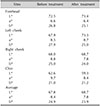This article has been
cited by other articles in ScienceCentral.
Dear Editor:
Low-level light therapy is applied to a diverse range of therapeutic fields, including therapy for pain relief, inflammation, and skin rejuvenation. Many reports have explained the beneficial effects of light-emitting diode (LED) therapy in skin rejuvenation, wrinkle reduction, and skin tightening
1. There are, however, few reports on the skin-lightening effects of LED
2. Herein, we present a report on the skin-lightening effects of an LED device, confirmed by colorimetric assessment.
For 3 weeks, a 44-year-old Korean woman was irradiated for 20 minutes, once daily with an LED mask device containing 72 LEDs emitting red and near-infrared light (650~840 nm). To objectively compare skin brightness before and after treatment, a mirrorless digital camera (EOM-M; Canon Inc., Tokyo, Japan) with a macro lens (EF-M 28 mm F/3.5 Macro IS STM; Canon Inc.) and built-in light source was used. Three representative parts of the face (forehead, cheek, and chin) were photographed under identical settings in the manual mode. We received the patient's consent form about publishing all photographic materials. Commission International d'Eclairage L*a*b* (CIELAB) values of each facial region were calculated to quantitatively measure skin brightness.
Regression analysis using a simple linear regression model was performed for calibration
3. Image software (ImageJ, version 1.46r; Softonic International SA, Barcelona, Spain) was used to acquire RGB values.
The pre-treatment forehead L* of 72.5 increased to 73.4 after treatment. In the left cheek, the L* value increased considerably, from 67.9 to 73.3. In right cheek, it increased slightly from 68.0 to 68.7. On average, pre-treatment calculated L* values increased from 67.8 to 68.7 after LED mask irradiation (
Table 1). No remarkable changes in color hue were visible after LED mask use (
Fig. 1).
Before and after photographs of the facial skin were analyzed using CIELAB coordinates to confirm changes in brightness. CIELAB values have been applied to evaluate skin brightness quantitatively in other studies
4. According to the results, LED irradiation improved overall skin brightness, indicated by an increased calculated L* value. These results were consistent with some of the findings of Lee and colleagues
5, showing skin-lightening effects of LED irradiation, and confirming these results by measuring melanin levels.
Most of the observed areas, including the forehead, and both cheeks showed improvements in brightness. On the chin, however, the calculated L* value decreased despite having been irradiated with the LED device. This may be due to post-inflammatory hyperpigmentation caused by the improvement of folliculitis on the chin, which was confirmed by the photographs. This could be explained by the calculated a* value decreasing from 9.7 to 8.4.
Regarding methodological aspects, it is important to obtain photographs under constant conditions free from the influence of external factors. As such, we used a nontransparent funnel-shaped spacer that provided the same distance from the subject to the camera sensor and dark space inside the spacer. This device can be used for other studies evaluating skin color.
Herein, we quantitatively report the effects of LED irradiation on skin brightness in a middle-aged Asian woman.
Figures and Tables
Fig. 1
(A~D) Photographs of skin before light-emitting diode (LED) treatment. (A) Forehead, (B) left cheek, (C) right cheek, (D) chin. (E~H) Photographs of skin after LED treatment. (E) Forehead, (F) left cheek, (G) right cheek, (H) chin. Change of color was not identified in any of the facial regions shown above.

Table 1
Pre- and post-treatment CIELAB values of each facial region

ACKNOWLEDGMENT
This research was supported by the Basic Science Research Program through the National Research Foundation of Korea (NRF), funded by the Ministry of Science, ICT & Future Planning (NRF-2017R1A2B4011001).
References
1. Avci P, Gupta A, Sadasivam M, Vecchio D, Pam Z, Pam N, et al. Low-level laser (light) therapy (LLLT) in skin: stimulating, healing, restoring. Semin Cutan Med Surg. 2013; 32:41–52.


2. Greaves AJ. The effects of narrowbands of visible light upon some skin disorders: a review. Int J Cosmet Sci. 2016; 38:325–345.


3. Kim JW, Seo SH, Kye YC, Ahn HH. Colorimetric measurements of iris colour and their significance in East Asian patients with skin cancer. Clin Exp Dermatol. 2010; 35:711–716.


5. Lee SY, You CE, Park MY. Blue and red light combination LED phototherapy for acne vulgaris in patients with skin phototype IV. Lasers Surg Med. 2007; 39:180–188.







 PDF
PDF ePub
ePub Citation
Citation Print
Print




 XML Download
XML Download